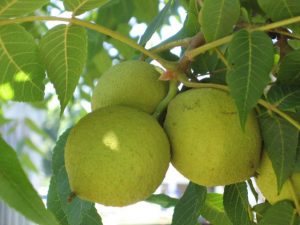We may receive a commission when you use our affiliate links. However, this does not impact our recommendations.
 This week in our newsletter, I wrote about going to a walnut festival and planting some of the fruits when I got home. It was my hope to see some seedlings in the spring. I asked readers if they had any advice, and I received a lot of letters. The following is some of what I learned:
This week in our newsletter, I wrote about going to a walnut festival and planting some of the fruits when I got home. It was my hope to see some seedlings in the spring. I asked readers if they had any advice, and I received a lot of letters. The following is some of what I learned:
There are great resources on the web. One reader sent me the URL for the Walnut Council, which was especially helpful. Apparently there is a serious problem for black walnuts trees called the Thousand Cankers Disease that has spread across the country in a short time. It kills the tree within a few years after it has been infested. The disease is caused by a fungus that is carried by a beetle that burrows in the bark cambium. It is believed that humans are causing the disease to spread by transporting pieces of the wood with the fungus and the beetles on it, so it is recommended that you don’t transport any black walnut wood that has any trace of bark on it.
As far as planting your own fruits, I got a lot of advice. The black walnut is native to the eastern U.S., but from the letters I received, there are walnut farms across the country, all the way down to Texas and out to California, but about 65 percent of the annual wild harvest comes from Missouri. Many readers suggested placing the nuts in the refrigerator in a plastic bag with a moist piece of paper for a couple of months as the nut must be tempered like it would be naturally during the winter.
So with all of the rain this spring, walnut trees had a bumper crop of nuts. Many readers wrote of collecting 20+ five-gallon buckets full of the nuts, but they say that usually only happens every other year.
Many suggested I build a sturdy fence around the seedlings because deer are quite fond of eating them, and that, because walnut seedlings have a strong taproot that develops really deep and cannot be cut lest you risk killing the tree, that you avoid transplanting them. They suggest that you pick your spot carefully and don’t move the seedling.
Which bring me to the toxicity of the tree. One reader pointed out that a loose Latin translation for walnut is “death to all.” Many readers sent dire warnings that the tree gives off a toxin that kills all nearby plants, but that is only partly true. It does give off a toxin, but there are many plants that are not affected by the toxin. Check out this site from The Ohio State University Horticulture and Crop Science Department for an extensive list and more information.
And finally, many readers wrote how you cannot use walnut sawdust in a horse stable for bedding, but that you can compost the leaves without any problems. Thanks to everyone who responded.
As many of you may know, Sam Maloof loved to use walnut for his furniture. We currently have a sale on a great package from Charles Brock, one of our Woodworking in America instructors. The package is called “Build a Maloof Inspired Rocker with Charles Brock,” and it includes a DVD, book, full size pattern, and online support through membership in a special club for builders of sculptured furniture.
Here are some supplies and tools we find essential in our everyday work around the shop. We may receive a commission from sales referred by our links; however, we have carefully selected these products for their usefulness and quality.







Important topic especially for those of us who love this native North American furniture wood. I was under the impression, though, that the etymology for walnut in latin (Juglans) is Jupiter’s Fruit (Fruit of the Gods.)
Thank you so much for the information about toxicity with other species. I found a black walnut in the woods walking my dogs recently and pocketed thinking to plant it along with some azaleas and viburnum. That would have been a disaster as the walnut would have killed the plants beside them and my really fruitful blueberry bushes too. I would have never known if I hadn’t read this truly valuable post. So again, thank you so much!
Hi Ajax,
I did this once in England…..real easy, if a bit messy. Just rub the nut on the driveway with your shoe to loosen up or remove the skin of the nut and then put in a dirt filled milk jug. Just lightly cover the nut…or simply press it down into the dirt and leave it be. Set the jug outside over the winter, and by spring you should have a baby tree. Gotta watch that tap root, though, so pick a spot for it soon (city park?) and plant it out by cutting out the bottom and side of the milk jug.
Be careful not to get the flesh on your hands, though, as it will turn them a rich (walnut!) brown that lasts for a week or two!
Cheers & have fun!
Derek